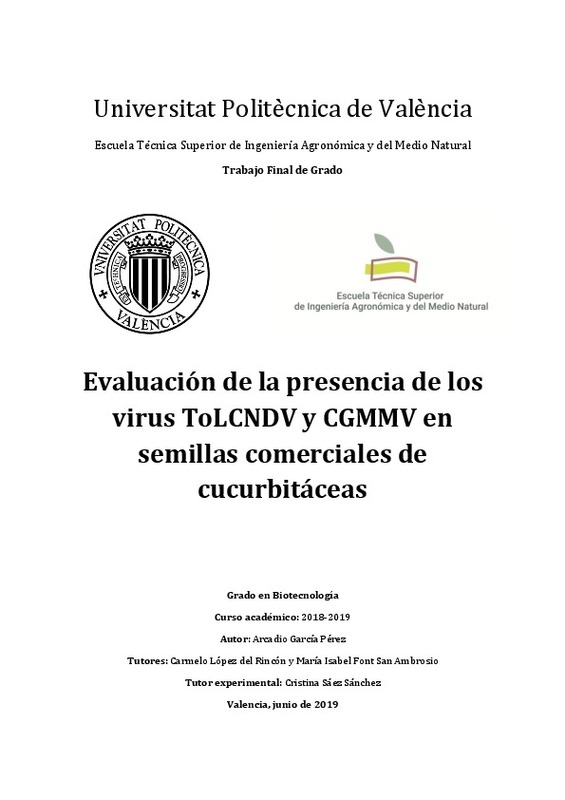|
Resumen:
|
[ES] Las virosis inciden de forma cada vez más grave en el valor final de la producción y en la
rentabilidad de los cultivos. Así, en algunas zonas geográficas han llegado a convertirse en el
principal factor limitante ...[+]
[ES] Las virosis inciden de forma cada vez más grave en el valor final de la producción y en la
rentabilidad de los cultivos. Así, en algunas zonas geográficas han llegado a convertirse en el
principal factor limitante del cultivo. De particular importancia son los problemas causados por
virosis emergentes. Dos ejemplos recientes de enorme gravedad se han dado los últimos años
en cultivos de cucurbitáceas del sureste español. Por un lado, en otoño de 2012 en Murcia y
Almería, se observaron síntomas de una nueva enfermedad viral en calabacín acompañados en
muchos casos de una parada del crecimiento. El causante de esta nueva enfermedad es el
virus de la hoja rizada del tomate de Nueva Delhi (Tomato leaf curl New Delhi virus, ToLCNDV).
El virus se encuentra ya muy difundido en España, afectando a otros cultivos como pepino,
melón, sandía, calabaza y tomate. Por otro lado, desde 1996 también se ha detectado el virus
del mosaico verde jaspeado del pepino (Cucumber green mottle mosaic virus, CGMMV)
causando daños importantes en las principales especies hortícolas de la familia de las
cucurbitáceas.
Un aspecto epidemiológico importante a tener en cuenta es el de la transmisión de estos virus
a partir de semillas procedentes de plantas infectadas. Las plántulas germinadas a partir de
semillas infectadas podrían actuar como primera fuente de inóculo en el campo, para su
posterior transmisión agravando el impacto económico en los cultivos. El objetivo de este
Trabajo Final de Grado se centra en comprobar si en semillas comerciales de cucurbitáceas
(calabacín, melón, pepino y sandía) es posible detectar los virus ToLCNDV y CGMMV. Si esto
fuese así, se analizará de que aislado se trata. La identificación de las fuentes primarias de
inóculo puede ayudar a reducir la propagación del virus y la gravedad de los efectos sobre la
producción de cucurbitáceas.
[-]
[EN] Virus diseases have an increasingly serious impact on the final value of production and the
profitability of crops. Thus, in some geographical areas they have become the main factor
limiting cultivation. Of ...[+]
[EN] Virus diseases have an increasingly serious impact on the final value of production and the
profitability of crops. Thus, in some geographical areas they have become the main factor
limiting cultivation. Of particular importance are the problems caused by emerging viruses.
Two recent examples of enormous seriousness have been given in recent years in
cucurbitaceae crops in southeastern Spain. On the one hand, in the autumn of 2012 in Murcia
and Almería, symptoms of a new viral disease were observed in zucchini accompanied in many
cases by a stop of growth. The cause of this new disease is the curly leaf virus of tomato of
New Delhi (Tomato leaf curl New Delhi virus, ToLCNDV). The virus is already widespread in
Spain, affecting other crops such as cucumber, melon, watermelon, squash and tomatoes. On
the other hand, since 1996 it has also been detected the green mottle mosaic virus of the
cucumber (Cucumber green mottle mosaic virus, CGMMV) causing important damages in the
main horticultural species of the cucurbit family.
An important epidemiological aspect to take into account is the transmission of these viruses
from seeds from infected plants. Seedlings germinated from infected seeds could act as the
first source of inoculum in the field, for subsequent transmission aggravating the economic
impact on crops. The objective of this Final Degree Project is to check whether it is possible to
detect the ToLCNDV and CGMMV viruses in commercial seeds of cucurbits (zucchini, melon,
cucumber and watermelon). If this were possible, it will be analyzed what isolate it is. The
identification of the primary sources of inoculum can help to reduce the spread of the virus
and the severity of the effects on the production of cucurbits.
[-]
|







